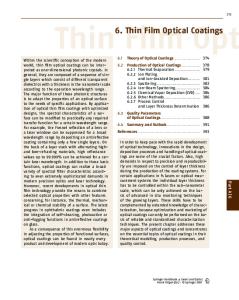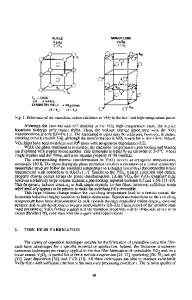Nanocomposite Thin Film Coatings for Protection of Materials Surfaces
- PDF / 104,000 Bytes
- 6 Pages / 612 x 792 pts (letter) Page_size
- 38 Downloads / 401 Views
J13.14.1
Nanocomposite Thin Film Coatings for Protection of Materials Surfaces R. Asmatulu 1, R.O. Claus 1,2, J.B. Mecham 2, S.G. Corcoran 3 and Y.X. Wang 1 1
Fiber & Electro Optics Research Center, Virginia Tech, Blacksburg, VA 24061, NanoSonic Inc., 1485 South Main Street, Blacksburg, VA 24060, 3 Materials Science and Engineering Department, Virginia Tech, Blacksburg, VA 24061. 2
ABSTRACT The present study deals with nanocomposite thin film coating, analysis and application steps for the corroding surfaces. Silica nanoparticles were incorporated into epoxy polymers, and then the obtained polymeric nanocomposites were sprayed on the Al coupons by a nozzle sprayer at different thicknesses. A urethane top layer was also coated on some of initially coated surfaces. Several electrochemical impedance spectroscopy (EIS) tests were conducted on the prepared samples using 0.5 M NaCl solution. The test results showed that the Al coupons coated by nanocomposites and urethane top coating gave the excellent corrosion resistance against the corrosion attack. As a result, it is assumed that the nanostructured coating system will allow military, private companies and government agencies to effectively protect the materials surfaces against corrosion. 1. INTRODUCTION As is known, corrosion is the destructive attack of a material surface by reaction with its environment (humidity, seawater, acid rains, emissions, pollutants, chemical by-products and industrial waste, as well as sunlight and heat). Interfaces at grain boundaries and interfacial cracks, and between two dissimilar materials are vulnerable sites for corrosion attack. Impurities, surface morphology and lattice imperfection in material structures can also enhance the corrosion rate [1-4]. Because of the materials’ degradation, corrosion causes plant shutdowns, labor cost, waste of valuable resources, loss or contamination of product, reduction in efficiency, costly maintenance, and expensive over design. This can also jeopardize safety and human health [2,4]. Consequences of the corrosion formation on the materials surface have become a serious problem worldwide and needs to be solved. The first step in preventing corrosion is to recognize its specific mechanism explained by electrochemistry, materials science and metallurgy. Electrochemistry that deals with existence of anodic and cathodic sites on the surface of a metal creating potential difference contributes an understanding of the mechanism that is basic to the corrosion of all metallic objects. Materials science and metallurgy provide knowledge of the characteristics of metals and their alloys as well as the methods of combining the various metals. The second step is to select and design appropriate materials to control corrosion [4-8]. Protective coatings are probably the most widely accepted systems for corrosion control. Therefore, thin film coatings are frequently utilized for the purpose of protecting metal surfaces against corrosion attack. These organic films including polyurethane, polyamide, polyester
Data Loading...











